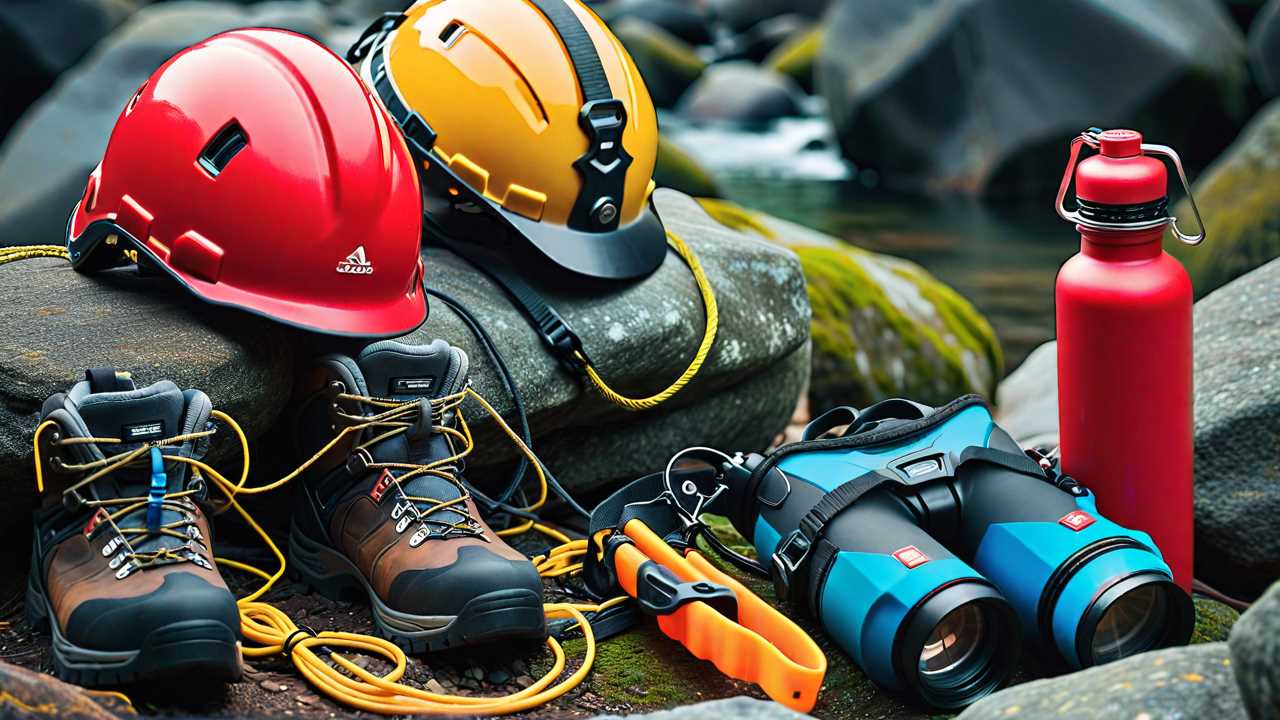
You've gathered your enthusiasm and courage; now it's time to equip yourself for the underground journey that lies ahead. From the darkness of the caves to the rugged terrain, journeying through these mysterious territories demands a set of specialized tools and gear to keep you safe and comfortable. But what exactly should you pack for this thrilling adventure? Let's discover the essential equipment needed to conquer the depths and challenges of caving.
Essential Safety Gear
Make sure you equip yourself with the essential safety gear required for caving expeditions to protect yourself in challenging underground environments.
First and foremost, a sturdy helmet is a non-negotiable item. Opt for a helmet specifically designed for caving, as it will provide vital protection against potential head injuries from low ceilings, falling rocks, or accidental bumps.
Additionally, invest in a reliable headlamp with a backup light source. Headlamps allow for hands-free illumination, important when moving through dark cave passages. Ensure your headlamp has a strong beam that can penetrate the darkness effectively.
Next, don't forget about sturdy footwear. Caving involves traversing uneven, slippery terrain, so durable, closed-toe shoes with good traction are essential to prevent slips and falls.
A pair of gloves can also be invaluable, protecting your hands from abrasions, sharp rocks, or rough surfaces.
Lastly, consider bringing a whistle to signal for help in case of emergencies.
Lighting Equipment
Make sure your caving kit includes a high-quality headlamp with a strong beam and a reliable backup light source for exploring dark cave passages effectively.
When choosing lighting equipment for caving adventures, consider factors such as brightness, battery life, durability, and versatility.
- Brightness: Opt for headlamps with at least 200 lumens to illuminate the cave environment adequately.
- Battery Life: Select headlamps that offer long battery life, especially if you plan on spending extended periods underground.
- Durability: Choose lights that are waterproof and impact-resistant to withstand the harsh conditions of cave exploration.
- Versatility: Look for headlamps with adjustable brightness settings and beam angles to adapt to different cave environments.
Having a reliable primary headlamp and a backup light source guarantees you can navigate through tunnels, chambers, and narrow passages with confidence.
Remember to pack extra batteries or a power bank to avoid being left in the dark during your caving expedition.
Climbing and Rappelling Gear
Make sure your caving kit is equipped with sturdy harnesses, ropes, and descenders to safely navigate vertical passages and cliffs during your caving expeditions. Harnesses are vital for securing yourself while climbing or rappelling, guaranteeing you're safely attached to the rope at all times. Choose a harness that fits comfortably and securely around your waist and thighs.
Ropes should be dynamic, designed to stretch to absorb the force of a fall, reducing the impact on both you and the anchor points. Ensure your ropes are free from cuts, abrasions, or any signs of wear that could compromise their strength.
Descenders are essential tools for controlled descents, allowing you to smoothly lower yourself down vertical drops. Popular descender types include figure-eight devices and mechanical descenders. Practice proper handling and familiarize yourself with the functioning of your chosen descender before heading into the caves.
Always double-check your gear and perform safety checks before each descent to mitigate risks and ensure a safe caving experience.
Guarantee your caving attire includes durable and moisture-wicking clothing as well as sturdy, ankle-supporting footwear for the best protection and comfort during your underground explorations.
- Clothing: Opt for synthetic materials like polyester or nylon for your caving attire. These fabrics are quick-drying and moisture-wicking, keeping you dry and comfortable throughout your adventure.
- Base Layers: Wear moisture-wicking base layers that fit snugly against your skin to regulate body temperature and prevent chafing.
- Outer Layers: Choose durable and abrasion-resistant outer layers to protect you from rough cave surfaces and potential snags.
- Footwear: Invest in sturdy, waterproof boots with excellent ankle support to navigate through uneven terrain and protect your feet from sharp rocks or debris.
Proper clothing and footwear are essential for caving expeditions to guarantee your safety, comfort, and enjoyment while exploring the underground wonders.
Frequently Asked Questions
Can I Bring My Own Snacks and Water Into the Cave?
Yes, you can bring your own snacks and water into the cave. Make sure they are in secure, waterproof containers to prevent leaks or spills. Pack lightweight, high-energy foods and a sufficient amount of water for hydration during your caving expedition.
Are There Age Restrictions for Caving Tours?
Yes, age restrictions for caving tours exist due to safety concerns. Operators typically require participants to be a minimum age to guarantee physical capabilities and maturity. These restrictions vary, so check with the specific tour company.
How Do I Prepare for Tight Spaces in Caves?
To prepare for tight spaces in caves, assess your physical abilities, practice controlled breathing, wear appropriate clothing, and use proper techniques like the "inchworm" crawl. Maintain calmness, focus, and communicate effectively with your group.
Is There a Maximum Group Size for Caving Expeditions?
When caving, remember safety first. Group size matters for efficient communication and safety management. A maximum of 10-12 people is ideal. Smaller groups improve teamwork, reduce environmental impact, and guarantee everyone's safety underground.
Are There Any Specific Medical Conditions That May Prevent Caving?
Certain medical conditions like severe claustrophobia, heart conditions, respiratory issues, or mobility impairments could prevent you from participating in caving. Always consult with a healthcare provider before attempting any caving expedition for safety.
 SportsHollywoodLifestyleFashionHome & GardenTrendsPrivacy PolicyTerms And Conditions
SportsHollywoodLifestyleFashionHome & GardenTrendsPrivacy PolicyTerms And Conditions
